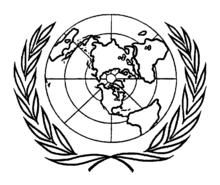The flag of the United Nations is a sky blue banner containing the United Nations' emblem in the centre. The emblem on the flag is coloured white; it is a depiction of the world map in the azimuthal equidistant projection (centred on the North Pole and the International Date Line), surrounded by a pair of olive branches. The emblem was officially adopted on 7 December 1946, and the flag containing the emblem was officially adopted on 20 October 1947.[1]


The flag of the United Nations consists of the white emblem on the sky blue background. The emblem depicts a azimuthal equidistant projection of the world map, centred on the North Pole, with the globe being orientated to the International Date Line. The projection of the map extends to 60 degrees south latitude, and includes five concentric circles. The map is inscribed in a wreath consisting of crossed conventionalized branches of the olive tree.[1][2]
The size of the emblem on the flag is one half the width of the flag itself. The flag proportions of the aspect ratio of the flag height to its width, are equal 2:3, 3:5 or to the same proportions as the national flag of any country in which the UN flag is flown.[2] White and blue are the official colours of the United Nations. The light blue background colour code is Pantone Matching System 2925. It approximates sky blue.[3]
The olive branches are a symbol for peace, and the world map represents all the people and the countries of the world.[2]


 The "United Nations Honour Flag", used as a symbol of the wartime allies, c. 1943–1948
The "United Nations Honour Flag", used as a symbol of the wartime allies, c. 1943–1948The organizers of the 1945 United Nations Conference on International Organization in San Francisco, California wanted an insignia that could be made into a pin to identify delegates. United States Secretary of State Edward Stettinius, Jr. was chairperson of the U.S. delegation, and realized that a temporary design might become the permanent symbol of the United Nations. He formed a committee headed by Oliver Lundquist that developed a design consisting of a world map surrounded by leaves from a design created by Donal McLaughlin.[4][5]
McLaughlin had previously worked as chief of graphics for the Office of Strategic Services that preceded the CIA. The azimuthal equidistant projection used in his design was heavily influenced by the maps created during World War II by Richard Edes Harrison, a popular cartographer working for Fortune and Life.[6][7].
The blue that appears in the background of the insignia was chosen to be "the opposite of red, the war colour",[8] although the exact shade has never been officially specified by the United Nations. The original colour the group chose in 1945 was a gray blue that differs from the current United Nations flag, unofficially called "Stettinius Blue", and it was selected because at that time it was not in use in any national flag[9] The globe used in the original design was an azimuthal projection focused on the North Pole with the United States, the host nation of the conference, at the centre. The projection that was used cut off portions of the Southern Hemisphere below 40 degrees south latitude, because that's where the Rand McNally map used as a model cut off, and the designers did not have time to find another map;[1] this was considered acceptable because Argentina, Chile and New Zealand were not yet planned to be members of the United Nations.[10] The projection was later altered so that the globe was centered on the International Date Line and extend to 60 degrees south. According to official explanations, the change was made to represent countries "as far as possible in their proper relationship to the cardinal points"[1] and "so the east and west were in balance".[5]
In 1946, a UNO committee was tasked to make a definite design, which was presented 2 December 1946. The emblem was adopted by the plenary session of the UNO on 7 December 1946, and the flag was officially adopted on 20 October 1947.[1]
According to the Convention on the Safety of United Nations and Associated Personnel, the emblem and the flag of the United Nations can be used by the personnel and material of UN peacekeeping missions as a protective sign to prevent attacks during an armed conflict.
The United Nations flag may also be flown as a garrison flag with other country flags. Garrison size is 10 feet by 30 feet.
The UN flag is the origin of a family of national flags. Because of the UN's association with peace and cooperation, UN-inspired flags are often adopted by states that have experienced conflict or instability. Many states with UN-inspired flags either were or were a part of United Nations trust territories.
The subnational flags, flags of constituent political entities of some states with UN-inspired flags, states that either were or were a part of United Nations trust territories, sometimes also derive inspiration from the flag of the United Nations.
The municipal flags of constituent political entities of some states with UN-inspired flags, states that either were or were a part of United Nations trust territories, sometimes also derive inspiration from the flag of the United Nations.